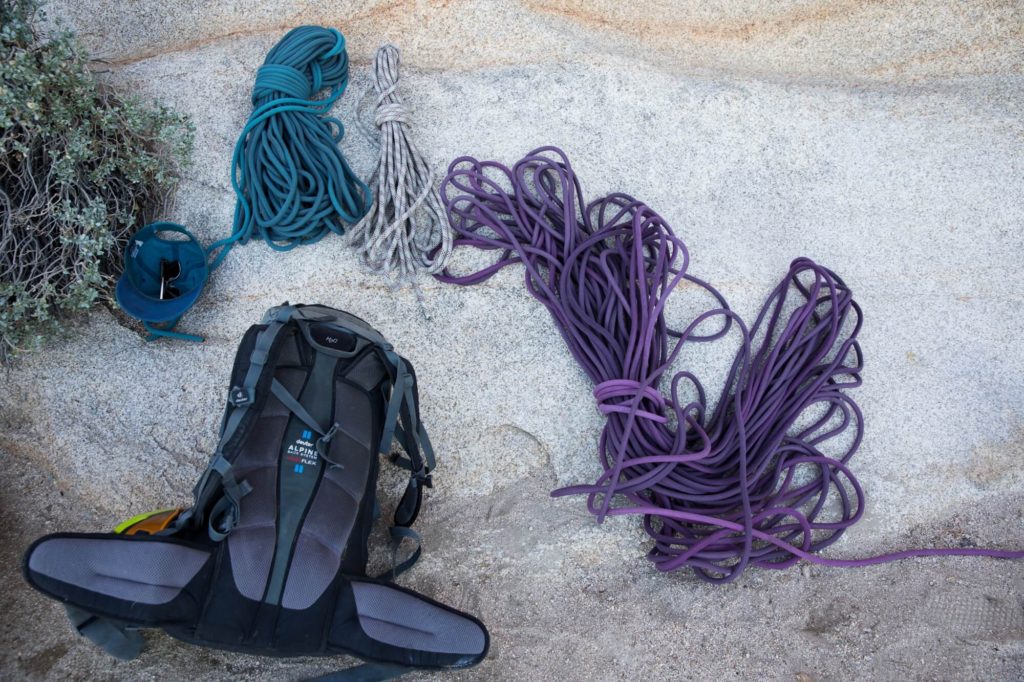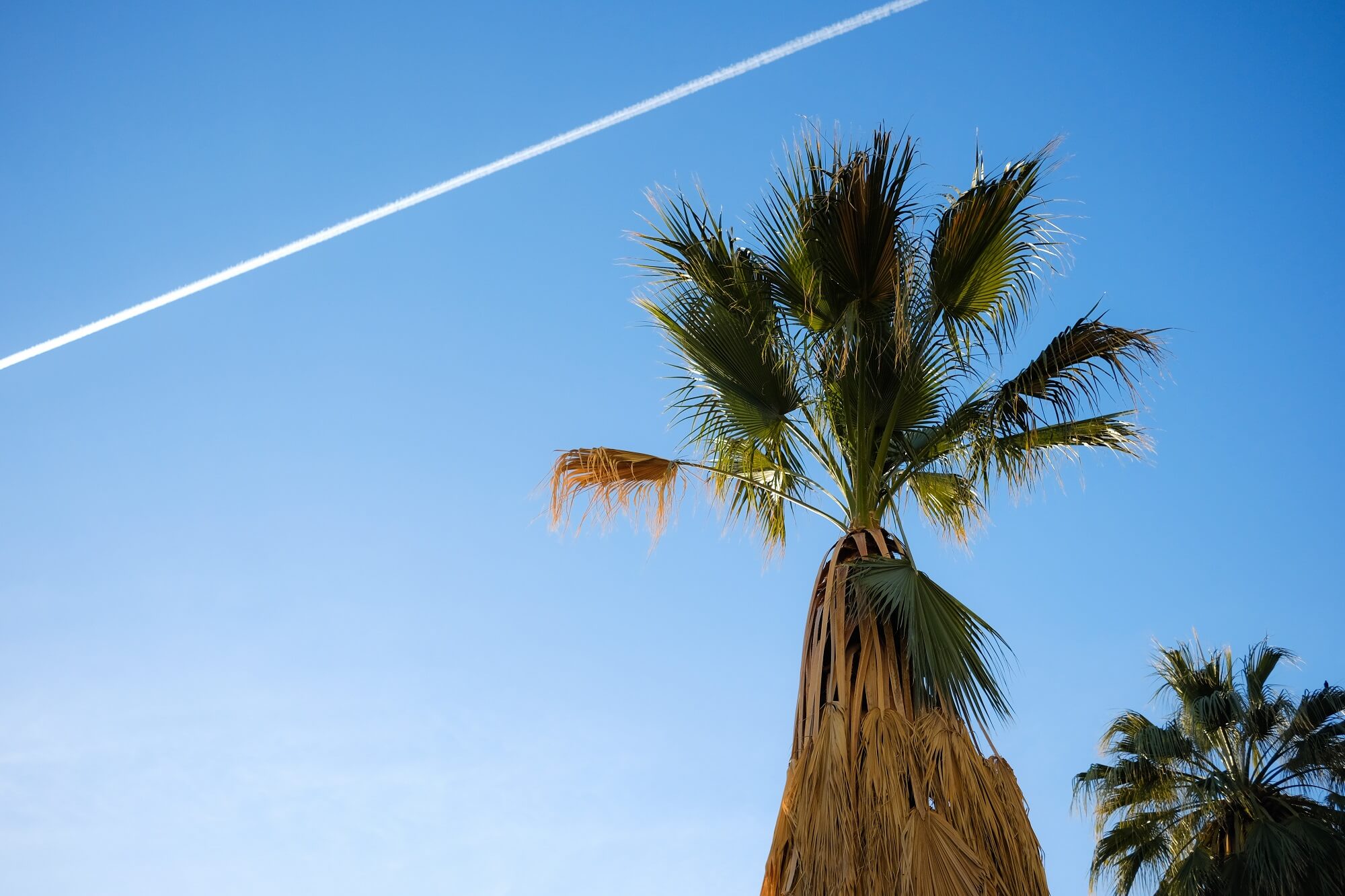
Your Joshua Tree rock climbing cheat sheet
Ready to do crack in the desert?
“It’s kind of the crack hot spot.”
I’m in the middle of Joshua Tree National Park talking to Annie Semmelroth, co-owner of Stone Adventures—and we’re talking not about drugs, but about rocks. Like the hulking rock in front of us, casting a shadow over us this chilly January morning as climbing guide Alex Kendrall skillfully maneuvers his way up it.
There are many reasons that people flock to Joshua Tree every year–nearly three million of them in 2017 alone–but a big one quite literally is because of the landscape. The formations that dot the 1,235-square-mile national park aren’t just Instagram-bait, but world-class rock climbing routes that attract newbies and profesh climbers alike (it’s considered one of the premier winter climbing routes in the world). “It’s actually really unique,” Semmelroth notes. “There are literally thousands and thousands of crack climbs out here—Joshua Tree has splitters, it has wide cracks, it has chimneys…it’s definitely an international hot spot for crack climbing.”

For serious dirtbaggers, their first climbs at Joshua Tree can be surprisingly challenging. “People who think they can climb 5.12 come here and they only climb 5.8. It’s very humbling,” says Semmelroth. Same goes for anyone who arrives expecting brightly colored holds and carefully plotted-out paths for you to follow. “It couldn’t be any more different than what you find in a gym—there aren’t that many holds, you have to place your own gear, you have to take it with you, you don’t necessarily see tracks everywhere—and that’s largely because of the climbing community here, the ethics, and because it’s a national park.”
And that might be what makes climbing Joshua Tree so special: Because it’s not just about the rock you’re scaling up (mostly a granitic rock called monzogranite, FYI), but what surrounds you as you do it. “Even though it’s famous for the climbing now, Joshua Tree became a monument for the plants,” says Semmelroth, pointing to one of the many yucca plants surrounding us and adding, “That is probably 400 years old. It’s like a jungle without water. It’s the driest place in North America, but every plant has a really interesting survival story.”

The same could be said for anyone who makes the move out here. “I like the climbing community—it’s kind of the same as in the desert: pretty rough around the edges, but there’s a lot of depth there too,” notes Aubrey Sheehan, a Joshua Tree native who started climbing three years ago. It’s that ruggedness that attracts so many of the residents here—although many of the climbers leave town from about May to September, because no matter how full your chalk bag is, it doesn’t stand a chance against the 100 degree-plus summer temperatures.
But if you’re Joshua Tree-bound during the cooler months, an afternoon climbing (even just an hour or two) is as required as getting a drink at Pappy & Harriet’s. Yes, even if you’ve never shouted “On belay!” before. “There’s definitely something for everyone—you could bring any level out here and they’d have fun,” promises Annie. (There’s no shame in hiring a guide, BTW—as Semmelroth notes, “The rigging is one of the toughest things.”)
- Photo: Chieko Kato
Here are the 6 stand-out climbs in Joshua Tree—whether it’s your first time doing crack (sorry, couldn’t help it) or you’re a total junkie.
The Eye
“It’s just beautiful–100 feet of really good rock quality. When you get to the top you’re in what’s called Cyclops Wall. From far away it just looks like the eye of a needle, so you’re standing in this kind of cave that’s open on either side and has such an amazing view…and then a very non-epic walk off. The climb is doable for anyone—it’s a 5.4.” —Annie Semmelroth
Intersection Rock
“Anything on Intersection Rock—there’s so many [laughs]. There’s a really cool climb there called Mike’s Books. It’s a relatively easy climb that goes up the side of Intersection Rock. A lot of people will solo that, because it’s a nice warm up. It’s a great way to start the day.” —Justin Jurgens

Bambi Meets Godzilla
“This is one of my favorite tracks. It’s a 5.9 trad one, and it has a lot of variety to it.” —Aubrey Sheehan
Double Cross
“That one’s really fun—you just climb up a slab to a crack. In the beginning the crack is really steep, but it’s just perfect hand-jamming. My friend did tell me that there are more accidents on this one than any other [in the park] though; it’s a 5.7, so everyone thinks it’s going to be easy—but it’s a Joshua Tree 5.7. If you’re a 5.10 climber, then you can go up.” —Annie Semmelroth

Sexy Grandma
“It’s a sport climb—which is pretty hard to find out here. You’re really exposed on the side of the cliffs. It’s hard pounding out there.” —Aubrey Sheehan
Cakewalk
“It’s inappropriately named—it’s really hard—but the scramble up and finish have an amazing view.” —Annie Semmelroth






